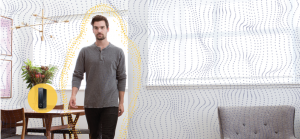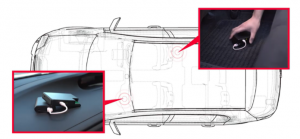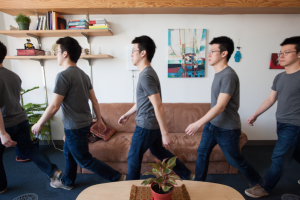Tech developers are transforming WiFi and connected IoT devices into sophisticated motion-sensing networks that promise a range of new services and benefits.
Personal safety and security among them, but so too remote medical treatment, eldercare solutions and wellness monitoring in the home, the office, and the car.
So-called WiFi sensing technology can be used to detect even subtle movements by measuring and interpreting changes in radio frequency signals transmitted between WiFi devices. Like waves rippling off a rock, WiFi transmission signals are affected by objects they encounter. Those subtle disruptions can be sensed and identified by technology. It can then be determined when and where and what kind of movements are happening (or not happening) by applying customized artificial intelligence programs and predictive analytic tools. A range of physical behaviours can be identified, including breathing, falling, sitting or walking, and even specific emotions can be assessed, simply by analyzing the wireless signals that get reflected off people’s bodies.

WiFi sensing can reliably identify someone’s motion, place and position. Cognitive Systems image.
WiFi sensing reliably identifies someone’s motion, place, and position without a video camera or wearable device. It can tell the differences among many motions, accurately identifying movements from a pet, an electric fan, or a human being – without ‘seeing’ or ‘tracking’ them in the usual way. Of course, WiFi reaches personal areas like bathrooms and bedrooms, so at least visual privacy does not need to be sacrificed in delicate home monitoring or sensing situations.
That’s how Cognitive Systems Corp. sees it. Since 2014, the Waterloo, ON-based tech company has been designing, developing, and implementing WiFi enabled motion sensing software in the market, making use of our many connected IoT devices to transform the entire home into a giant motion-sensing network.
Cognitive Systems launched its first home monitoring solution, called Home Aware, and the company has recently expanded its solutions by launching Caregiver Aware, a solution for elder care.
Underpinning these products and services is the company’s patented WiFi Motion software, available for an expanding range of WiFi access points and frequency bands. Cognitive says its deployment enables the sensing and deciphering of movement anywhere WiFi signals are present. A router with WiFi Motion software turns almost any connected smart device into a motion sensor. WiFi Motion also uses predictive analytics to determine the baseline in a motionless home environment, against which it can compare motion patterns and over time, giving behavioural insights about people in the home.
Such capabilities are driving the growing field of remote eldercare with a safe monitoring tool for seniors aging in place (and, as described below, for youngsters playing in a car).
In fact, since 2020, WiFi Motion’s availability has grown to over 2.5 million motion-capable devices and is offered by more than 100 service providers.
The company is working with various industry manufacturers, like Qualcomm, Broadcom, and Quantenna, to boost compatibility and market uptake. It can also be integrated with Google Assistant, Apple HomeKit, Amazon Alexa, and other proprietary interfaces.
Just recently, Cognitive Systems reported its WiFi Motion technology will run on MaxLinear chips, and that California company’s suite of WiFi, fibre, DOCSIS, and xDSL products. WiFi 5, 6 and 7 products are also compatible, and the company is collaborating with various industry groups, including the Wireless Broadband Alliance Ltd. CO. (WBA), Wi-Fi Alliance, and Institute of Electrical and Electronics Engineers (IEEE), to extend the reach of WiFi sensing services and enable the next generation of smart homes.
Or smart cars.
Attendees at the WiFi Alliance Lisbon trade show recently saw a demonstration of WiFi sensing for automotive use. Child Presence Detection (CPD) leverages WiFi to detect if a child is unattended in a vehicle and can also determine if they are moving and breathing.
The CPD solution (developed by a partnership led by Japanese tech firm Murata, with Canadian offices in Markham, ON) uses artificial intelligence-driven WiFi sensing programming from Origin Wireless to process existing WiFi transmissions. Origin’s patented applications are used to build WiFi smart homes, automotive products and enable health and well-being services.
In the demo, the technology detected the presence of a child in a vehicle and was shown to be able to detect even slight environmental changes in real-time, including biometric variations like respiration.

Wi-Fi units are installed in a vehicle to enable motion sensing. (source: Murata)
Two WiFi modules are required to detect a child in the car, the tech partners described, and existing WiFi systems like in-vehicle infotainment, navigation or telematic control units can be used for CPD, once sensing software like that from Origin Wireless is installed.
Both front seat and rear seat can be sensed and small movements like breathing can be detected. Even a child under a blanket on the floor can be detected.
Such sensing detail and specificity will only increase. The next-gen wireless standard, the 802.11 bf protocol, could enable sensing technology to make use of both low-frequency waves (1 GHz to 7.125 GHz) to sense motion in a large room, for example, and high-frequency signals (45 GHz and above) to sense movements at shorter ranges, like recognizing your hand gestures when you’re working at a laptop or speaking excitedly on the phone.
# # #

Academics, researchers and technologists are tweaking the motion detection capabilities of WiFi by analyzing wireless signals and their reflections off encountered surroundings, such as a person’s body. Walking – stride length and gait speed – is easily detected. But algorithms can distinguish walking from other movements, such as cleaning the kitchen or brushing one’s teeth. A range of behaviours can be identified, including breathing, falling, even specific emotions, simply by analyzing the wireless signals that get reflected off people’s bodies. WiFi can also be used to estimate the number of people inside a room from the outside. Image: MIT.
-30-



